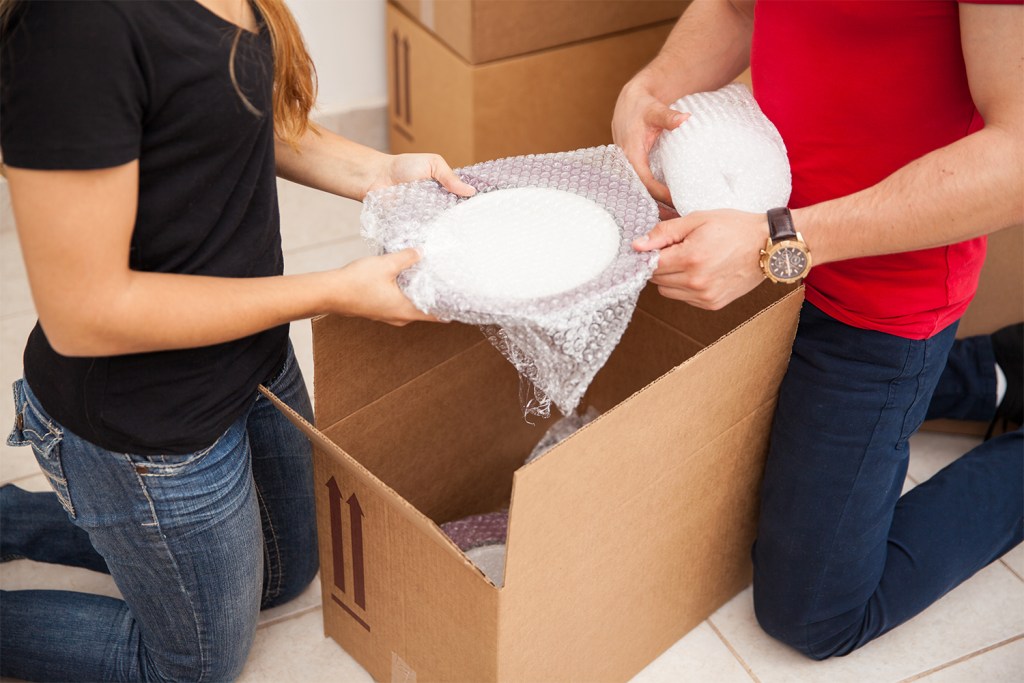Time to move again? Do you have everything you need? Are you applying all the moving and packing tips you’ve learned while in the process? How about packing materials – did you decide on newspapers again, or something else this time? It can be such a stressful and overwhelming endeavor to relocate, most people hardly have the time to get everything packed up, let alone doing proper research to make sure we have the most sustainable packing materials.

Well, rest easy. We did the research for you! Come see the most popular types of today’s packing material and see which kind is best for your move:
*Note: Prices appear to vary extensively due to location and other factors. We decided it’s better for customers to seek out the packing materials they like locally and find out the rates for their use.
Excelsior
This is a product made of natural wood slivers from cut Aspen logs, which is primarily used for packing material. You may also find it in gift baskets, used for fire fighter training, and more. One advantage to this packing material is that you can compress and mold it into shapes and contours around your belongings to hold them firmly in place. It’s also reusable, dust-free, and biodegradable. Eight ounces of excelsior can support up to 3 pounds.
Shredded paper/crinkle paper
Shredded paper (also called crinkle paper) is lightweight and simple to pack with, especially between heavier items so you won’t make the box impossible to lift. This should be considered somewhat eco-friendly when used for packing, as it would otherwise likely go to waste. Some shredded paper is a beige, or paper bag color, while other kinds are available in numerous colors. The regular beige is most suitable for packing while the colorful crinkle paper looks better for gift wrapping.
Cushion wrap/foam wrap
Cushion wrap is puncture-resistant and cushioned to pack around items with sharp edges. It often comes in a convenient roll and is perforated every 12-inches for easy tearing as needed. Foam wrap is similarly cushioned and perforated, but also moisture-proof. Both kinds are reusable and handy for wrapping items with sharp edges carefully.
Bubble wrap
Everyone loves to pop it! Bubble wrap is easy to use and protects your belongings well. Get a roll of regular bubble wrap or go for an eco-friendly variety like this which uses recycled content with up to 20% from post-consumer sources. Both kinds are perforated intermittently for easy tearing off as you need for packing.
People love to pack with bubble wrap, but additional packing sources may need to be used with it to keep things in place. One advantage is it’s usually clear or see-through so you can identify contents easily while moving. Some like to wrap the individual items in bubble wrap, and others like to reinforce the inside of the boxes with it along each side as well for extra cushion.
Packing paper
This can be anything from old newspapers to junk mail, reused tissue paper, holiday wrapping paper and cards, paper towels, napkins, notebook paper, shredded documents, or whatever papers you may have around. If you can use it to create cushion around your belongings, hold onto it for your move – it may come in handy and save you some money!

Stretch wrap
It stretches around furniture holding it together for the move. It’s probably best known for stretching around dressers to hold drawers in place so they won’t fall out while being moved around. It’s also great for bundling up a drawer-ful of kitchen utensils to hold them together for the move.
Packing peanuts
Packing peanuts are always a win with kids and pets to play with but be careful they don’t ingest any – although most kinds are said to be non-toxic anyway. These little nuggets are small and soft enough to get into the spaces you need filled and keep your treasures safe during transport. Go for the biodegradable variety if you can swing it; this way it’s a little more eco-friendly.
Cellulose wadding roll/Corrugated wrap roll
This is a multi-layer cushioning fabric also sold on a roll, soft and absorbent, and perforated every 15-inches. This can go around breakables, perfect for glass wine bottles, and similar. Corrugated wrap roll is similar but made of corrugated cardboard. It’s excellent for protecting items en route to your destination. Highly puncture resistant.
Rentable, reusable moving boxes and other ideas
If you want to stay on the eco-friendly theme, consider looking into renting reusable boxes. Some of these include:
- ZippGo, (California locations) Bungo Box, (mostly Florida locations), Bin It, (New York, New Jersey, Philadelphia, etc.), and Rent a Moving Box (mostly L.A., San Diego, and Orange County, CA).
- If you’re pressed for time, check out some stores’ deals, such as Home Depot’s 10-box kitchen moving kit for $51.75, or their 6-box dining room moving kit for $40.00.
- Use reusable moving boxes with towels, sheets, blankets, etc. for packing between fragile items.
- Check out companies like Ecoenclose.com for eco-friendly packing products.
Now that we’ve covered some of the best packing materials and other ways to get moving, you should be ready to decide which types will work best for you. Be sure to ask your moving company if they have observe any environmentally friendly practices or whether they reuse their boxes or other materials. If they don’t, feel free to call around to see if others do.
Related: Best Vehicle Shipping for Your Next Move
Of course, there’s always the old-fashioned way of getting reused boxes on your own as well. Hit the grocery stores and ask the workers in the back if they have any extra boxes they won’t need; drive by the area dollar stores and others (be sure to ask permission before removing anything from any area of a business – up to and including the dumpsters) and ask around the popular department stores employee entrance to see if they have anything to get rid of – and then be there when they’re ready to toss it out.
Good luck with your move and be sure to stop back any time you need ideas! We’ll be here updating and sharing our latest finds on packing, moving, and a variety of other topics. Thanks for visiting!



